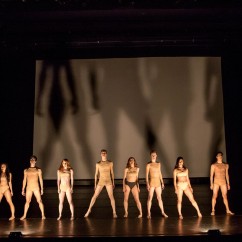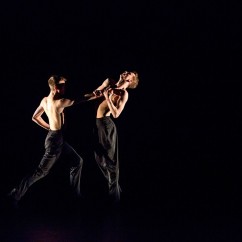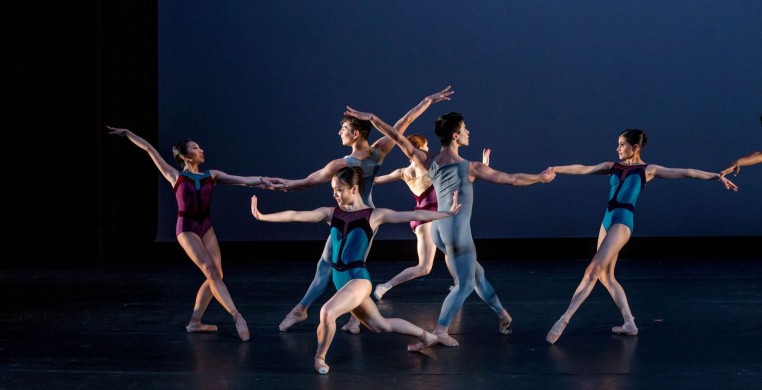Each year, the Joffrey Academy presents its Trainee Program and Studio Company dancers, giving the next generation of dancers a chance to shine. But this is no typical dance recital. Instead, the 8th annual Winning Works program presents up to four world premieres selected from a competitive pool of emerging ALAANA (African, Latino(a), Asian, Arab and Native American) choreographers. As per usual, last weekend’s Winning Works was a polished, high-quality production featuring student and pre-professional dancers of the highest caliber.
Native Chicagoan Luis Vazquez, who started dancing in Joffrey’s After School Matters program, opened the program with “Sea of Comets.” Set to music by Ezio Bosso, the dancers double as celestial beings, wearing simple, gender-neutral wrap dresses (by Luis Razo) of rich, jewel-toned colors. The video intro to the piece talks of Vazquez’s intention to make a dance about duality, but its two sections are not wholly yin or yang. Vazquez layers his big cast in crisscrossing lines with pretty promenades and comet-y looking cartwheels. Instead of a big fireball in a deep abyss, “Sea of Comets” feels like tiny, somber starbursts in a cool and dreamy moonlit glow created by lighting designer Claire Chrzan. I kind of wanted more of a fiery supernova – a big choreographic apex and brighter front light to give this piece the big punch it deserves. Then again, comets aren’t supernovas, and for me the thought-provoking moment comes at the end. With the whole cast facing on the downstage diagonal, they sharply look out at us, and then boom. Lights out. It made me wonder: All the time spent gazing out at the cosmos – is the cosmos gazing back at us? Luis Vazquez's "Sea of Comets"
Luis Vazquez's "Sea of Comets"
Telmo Moreira’s “Memento Mori” portrays the afterlife reflected in the title quite literally. An opening pas de deux dressed in white opens the piece, in front of black flowy panels hung from a mid-stage traveler. Behind the panels are groupings of dancers cast in orange silhouettes until a single dancer emerges from the pack dressed in red velour trunks and crop top. There’s a clear delineation between heaven, hell, and purgatory in these groupings, and it’s a beautiful visual effect. But there’s a lot going on here and it almost feels like the effects are too rushed to really let the meaning land on those of us who are watching. Moreira, who is from Portugal and just recently joined the faculty at Philadelphia’s prestigious Rock School for Dance Education, layers “Memento Mori” with his experience as a racially diverse person in the arts, and in the end of the piece, everyone ends up figuratively (and almost literally) naked, dancing together (minus the couple in white). Perhaps this is meant to show that, at their core, human beings are all the same, but dancers stripping down to underwear and letting their top knots out felt unnecessary in getting that symbolism across. Telmo Moreira's "Memento Mori"
Telmo Moreira's "Memento Mori"
Richard Danielpour’s 1988 score “First Light” is the primary source of inspiration for Claudia Schreier’s choreography in “Night Vision,” the third of four pieces on the Winning Works program. It is abundantly clear that she carefully studied the music, which draws from Danielpour’s primary influences: Igor Stravinsky, Aaron Copland, and Leonard Bernstein. Schreier similarly employs a neoclassical aesthetic that tastes a lot like the works of George Balanchine or Jerome Robbins, so the bigger theme here is about generational artistic influences, or “standing on the shoulders of geniuses,” as Schreier said in her introduction. Honestly, I was surprised that I liked this piece so well. It is unforgiving and difficult – so much so that it nearly got away from these dancers at some point. But honestly, I’d challenge any pro dance company to do better, and Schreier’s keen attentiveness to every single note of the score is what makes the whole thing work.
Lastly, “Boa,” by Puerto Rican choreographer Omar Roman de Jesus, enlists a playlist of lyrical music and Latin beats to create an abstract story about self-love. Each of the 12 dancers wears khaki-hued leotard tops and high-waisted, wide-hipped trousers (by costumer Mark Gieringer), liberating the dancers from stereotypical gender roles which, consequently, makes for a really satisfying duet for the piece’s two men: Jonathan Dole and Rees Launer. The tall and gangly blonds twist themselves into pretzels and unwind, then do it again, and the whole piece expands and recoils in a really gratifying way that reminded me of Gustavo Ramirez Sansano’s early dances for the now-defunct Luna Negra Dance Theater. How fitting; de Jesus just recently joined up with Ballet Hispanico, led by Luna Negra’s founder Eduardo Villaro. "BOA" by Omar Román De Jesus
"BOA" by Omar Román De Jesus


